Road haulage of 21st century is no longer a romantic adventure as it used to be even 25 years ago. The market is dominated by big companies, trucks in Europe are channeled mostly to motorways and human touch is less and less needed. Today this business is often less about transporting goods, more about feeding excel files with numbers in such a way, that colourful charts make guys in ties, who never even sat behind a wheel of the lorry, happy. I’ve been writing about this some time ago. But there are still places in which things are going in more traditional way.
Through the rabbit hole
A work of a driver becomes more and more boring. Today most truckers spend endless hours looking at the back doors of the lorry that precedes them on the motorway surrounded by acoustic screens or sitting at the plastic chair in a driver’s waiting room in yet another “regional distribution centre”. A brief lecture of the internet forums of the haulage industry reveals that drivers long for “good old times” where they were driving their Jelcz or Albions towards the adventure. Today both Jelcz and Albion are forgotten by the haulage industry – Jelcz manufactures short series of specialized trucks for the Polish army and in Albion’s factory in Glasgow Scotstoun component for other trucks are manufactured. So if someone wants to grasp a feeling of how things used to be, it is not the Albion site, where an old symbol on the signboard seems to be the only thing connecting it with the past, but rather place across the street from it that it is THE place to visit.
Here, at the end of the furniture warehouse, there is a narrow tunnel that leads to another world. The only indication that it’s worth to venture inside is a small sign saying “Hebrides Haulage – enter here”. And when we come out back to the sunny autumn afternoon on it’s other side, we will be in another world. In front of the brick warehouse, there is a medium size yard with a rusty lamppost. There, a few trucks, couple of trailers and stacks of pallets will be scattered in a seemingly chaotic way. The place will be busy like the insides of the beehive, some trucks will be loaded, some other will be taken off the back of the lorries, and between all that chaos a regular punters will try to find place to park their cars and drop parcels to the office or pick up goods addressed to them from the warehouse. All this, together with the way the trucks will be loaded, will contribute to the picture that most of us knows rather from documentary movies from Africa, Asia or Latin America.
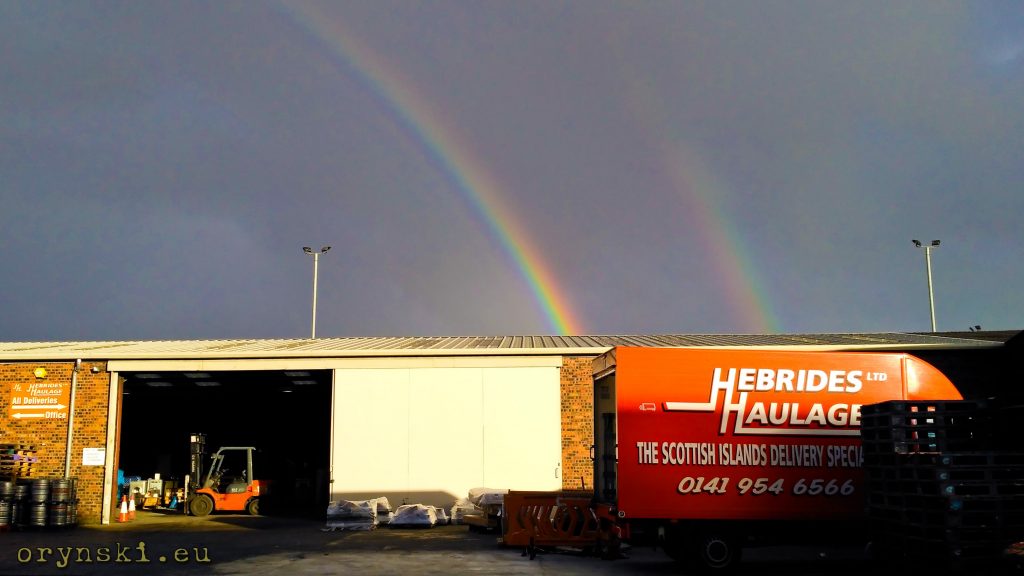
„My lorry is over the ocean”
Welcome to the world of the niche transport. Hebrides Haulage does what it says on a tin. It provides haulage services to the Scottish archipelago of Outer Hebrides, scattered along the north-west coast. This archipelago is inhabited by approx 30 000 people, that, apart from the biggest town of Stornoway, are scattered across the islands from Vatersay, just a small causeway ride from Barra in the south to the spectacular cliffs of Butt of Lewis in the north. Those two points lie slightly more than 200 km apart and this distance can be travelled thanks to stone causeways connecting some islands, and ferries, that cross bigger straits (and also connect Outer Hebrides to mainland and Skye). It is not easy to get there – nothern part of the archipelago can be reached after 6 hour drive to Ullapool and then few hours on the ferry to Stornoway. Centre of archipelago is served by the ferry from Uig at the top of Skye, from where there is also over 5 hours drive to Glasgow. Best way to get to the southern bits is to drive 3 hours to Oban and then enjoy over 5 hour long ferry crossing. In any case, one way journey can take almost all day, no wonder that most transport companies is happy that they can leave this job to a specialists.
On the other hand, we have to remember that there is less people living in Outer Hebrides than in a small Polish town of Dzierżoniów. The island’s economy is based mostly around fishing industry, sheep farming and tourism. There is no industry on a significant scale, unless we count manufacture of famous Harris Tweed as such. All that factors are responsible for the fact, that Hebrides Haulage rarely has to deal with transporting goods in bulk. In most cases it is rather single pieces or small pallets, a load of few pallets is considered big, and full loads are almost unheard of. This is why the warehouse is full of the goods and parcels in almost all sizes in dimensions. From small parcels (as even the biggest players in parcel industry do not venture out to the islands) through boxes, beer kegs, fridges, washing mashines, furnieture, small pallets, crates and cages to building materials, concrete prefabricates, vehicles, farm mashinery and boats. This is why loading a truck requires more consideration than just placing several pallets in a neat row.
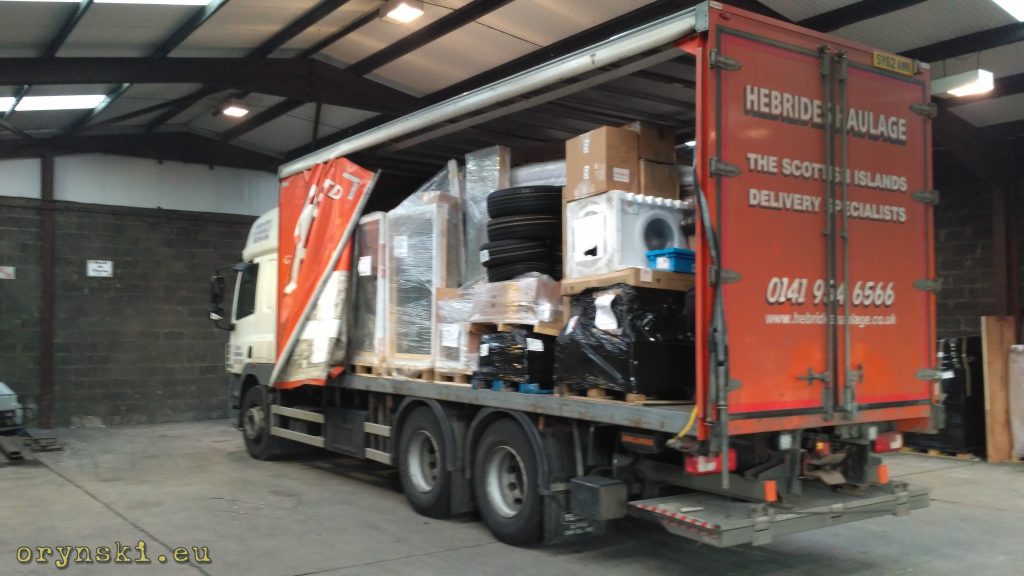
Tetris
Did you ever played Tetris? Imagine, that your work is to play Tetris, but in five dimmensions. Apart from trying to match shapes of the loaded items along vertical and horizontal axles, you have to remember to do not go over permitted axle weights. And to top it all, not everything can be double stacked. At the same time, you have to maximalise use of the space, so every small gap in the load has to be filled with a small box or parcels. This is because, unlike “normal” transport company, Hebrides Haulage faces much higher costs than, for example, a truck operating between a couple of warehouses located along some German motorways.
The thing is that while Islands import almost evertything from the UK Mainland and rest of the world, their major exports are fish and other seafood. Therefore while refrigerated vehicles can count on some back loads, vast majority of goods in general haulage are transported one way only. The sporadic return loads are mostly empty beer kegs and recycled household appliances. Meanwhile, trucks travel on significant distances in mountainous conditions and empty runs are nothing unusual – especially that it is not unheard of to send 26-ton truck few miles off it’s way to deliver small parcel: at first glance it might not sound like the most economical way to do it, but when the truck is already there, would sending a small van for a 10 hours journey to deliver that parcel be any wiser?
The company is forced to think out-of-the-box to find ways to cut it’s cost. As the ferry company charges per meter of the deck occupied, you can save a little fortune if you use flatbed trailers, as after dropping the load off, you can put it on the back of the lorry and save money on the crossing. Hebrides Haulage’ flatbed trailers are designed with this in mind and fitted with a special slots allowing forklifts to load/unload them from the lorry.
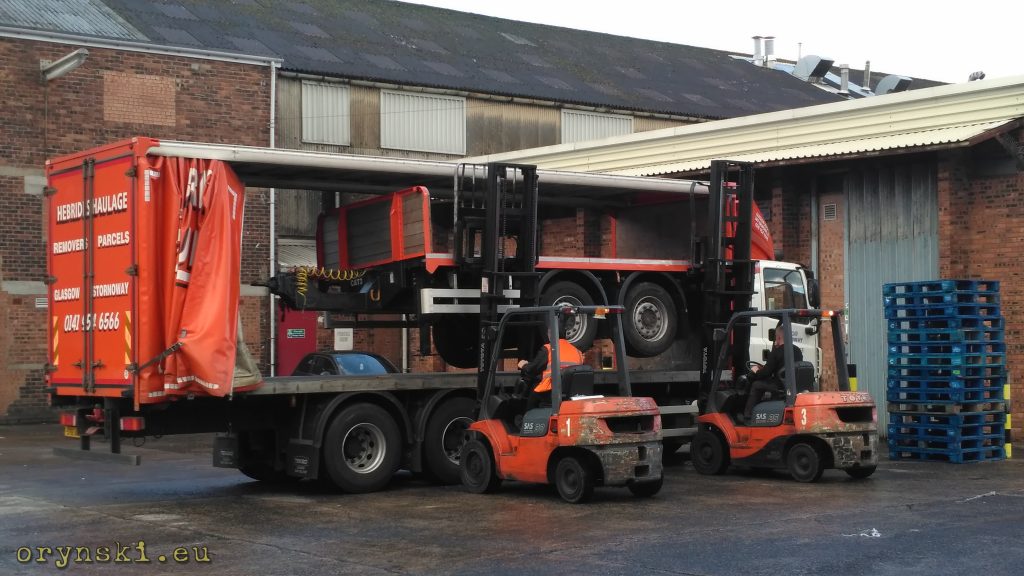
But every coin has two sides. Flatbed trailers help to save money, but securing loads on them requires some experience, especially when the route leads through a bendy roads in Scottish Higlands ofter battered by harsh weather. The sight of an shapeless figure covered with tarpauling secured by several ropes would propably cause a heart attack in an average BAG inspector in Germany, but the years of experience prove, that while there might not be an ISO norm for this, skillfully secured cargo can be perfectly safe.

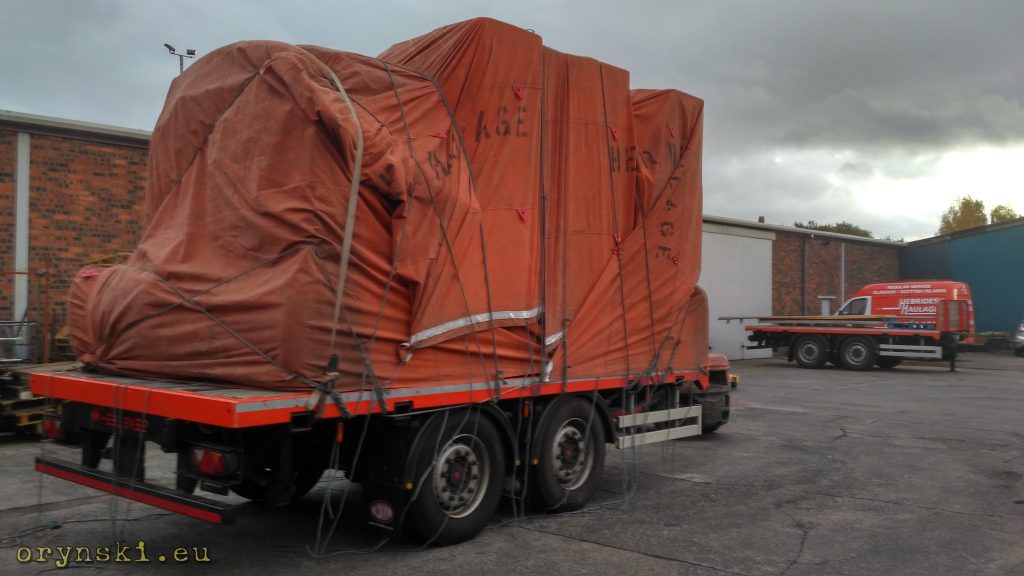
Battling the Weather
There is an old Polish joke in which Scots say that weather is nice every time the rain is vertical. Of course, as usually with jokes, this is a great exaggeration, but it does not mean that Hebrides Haulage trucks don’t have to face severe weather conditions. Especially in winter, when islands are battered by heavy storms, delays and cancellations of ferries are nothing unusual. And we have to remember, that this is not La Manche, where ferries to France and Belgium pass each other in the Dover port like if they were entering a busy mail via revolving doors. Even most busy routes to Hebrides have only few sailings per day, and to some places there is only one or two ferries per day. Some smaller islands are visited by a vessel only few times per week. Those waters are also not the easiest ones to navigate – just recently one of the ferries went out of control in Lochmaddy. But even if ferry traffic is not disrupted, you still have to get to port on time. Yes, it’s true that Scottish Highlands are not exactly world capital of traffic jams, but the road network is very sparse, so a road closure might result in diversion that adds several hours to your journey. And roads are not closed only due to accidents or roadworks, but also during severe storms or, as usual in Britain, when there is more than 1 cm of snow on the tarmac. And if the snow gates are closed in A9, there are still some alternative routes, but if Skye Bridge is closed due to strong winds, there is nothing else to do but park outside nearest pub and await news over a cup of tea. The only consolation might be that in that circumstances, ferries are propably cancelled anyway as well.

Fleet
Stormy weather and salty breeze from the see are the every day conditions that the company’s fleet has to work in. A bunch of DAF CF trucks bravely stands up to the elements. In the past, the company was also using Volvos, but in recent years it has been decided to rely solely on the Dutch brand. But Hebrides Haulage DAF’s are not your standard issue vans straight from production line – every single of them is tailored for the specific requirements of the company. And I don’t even speak about such perks as bars of extra headlights – as those are not just flashy gadgets, but, along with additional reversing lights, help drivers that cross the vas emptiness of North-Western Scotland during long wintery evenings.
12 metre 26 tonners represent the core of the fleet. They work nearly 24 hours per day, as usually such vehicle collects loads from central belt of Scotland and then, about lunchtime, returns to base to become a board of that Tetris game mentioned before. At dawn they are coupled with trailers and head north, when around Dingwall they meet they peers coming down from Isle of Lewis. Drivers exchange places and head back, so in Glasgow the same vehicle is present every second day. During odd days the vans work in the company headquarters in Stornoway along with other vehicles that are based there permanently. Those vans at first glance look most “normal” from the whole fleet, but at the closer inspection they reveal a few differences. Firstly, the vans are slightly higher than in Europe – at approx 4.2 m they fit perfectly into the warehouse or, if the need arises, under the rail bridges on the way to Malaig, and at the same time those few inches extra multiplied by the area of the loading space provide those valuable few cubic metres extra. Secondly, unlike typical wagon-and-drag trains that consist of the trailer with long thill and lorry with a coupling just behind rear axle, here the coupling is located at the end of the truck’s frame. This helps to pull the trailer along narrow bends and allows to drive over arch bridges, that are still quite popular in Scottish Highlands.
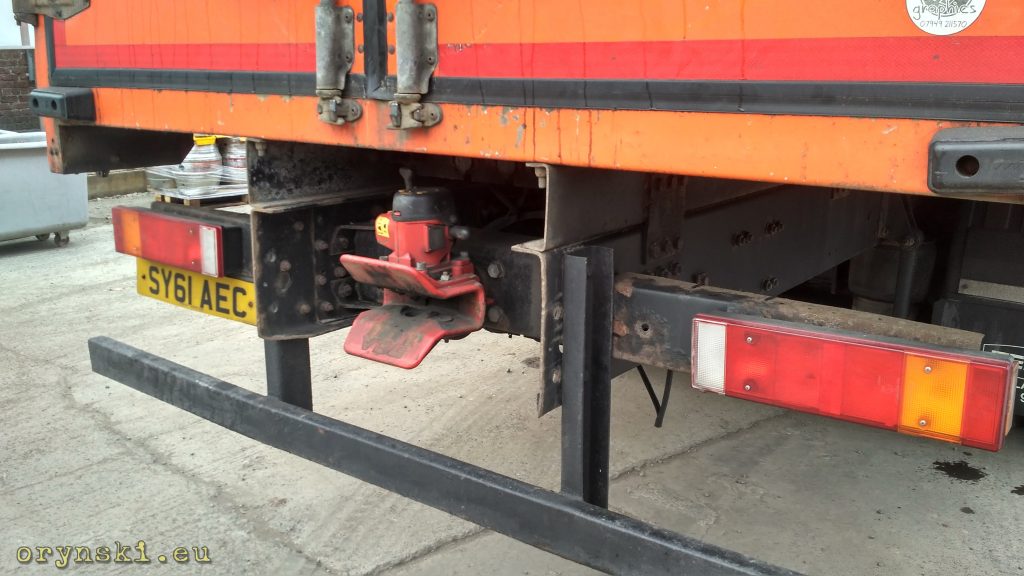
The other route served regularly by 12 metre DAF CF’s is a route to the company’s third base, located in Dornie, just before Skye Bridge. Here the things are going more bizarre, as on this route company carries also fresh fruit, vegetables and flowers. This is why the lorries serving this route can be recognized by the refrigerating equipment mounted above driver cab. Apart from that those lorries look just as the other lorries, but there is a secret: roof, floor, headboard and back doors are insulathed, and so are the side curtains. So while lorry is perfectly good to use as an ordinary curtainsider, it is also capable to keep it’s cargo chilled when necessary.
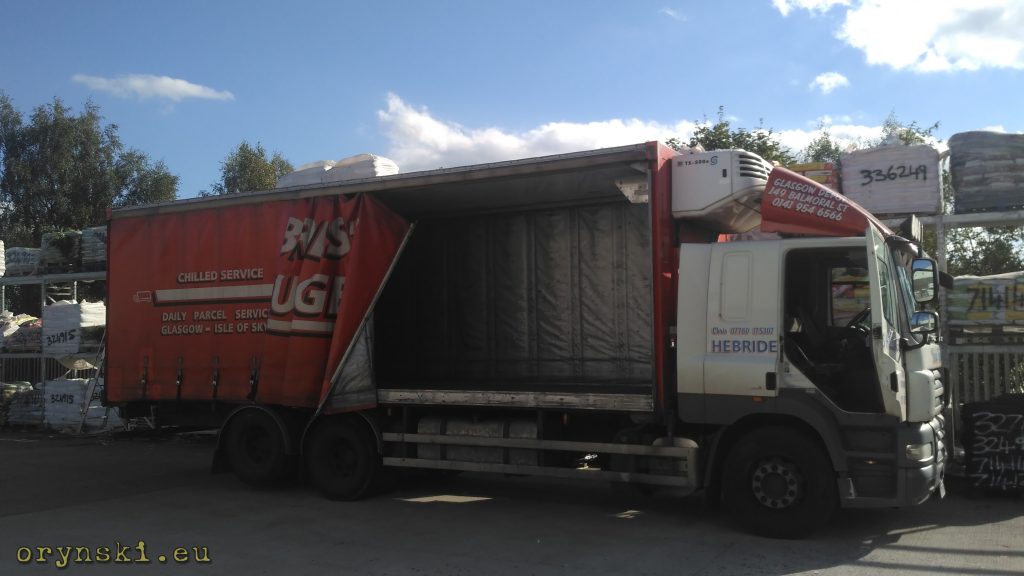
Lorries that serve that route are sharing their load with 7.5 t DAF LF and a Transit Van based in Dornie, as they serve not only Isle of Skye, but can be also met in the whole of Wester Ross as much north as Ullapool (Additional vehicles are also based in Stornoway).
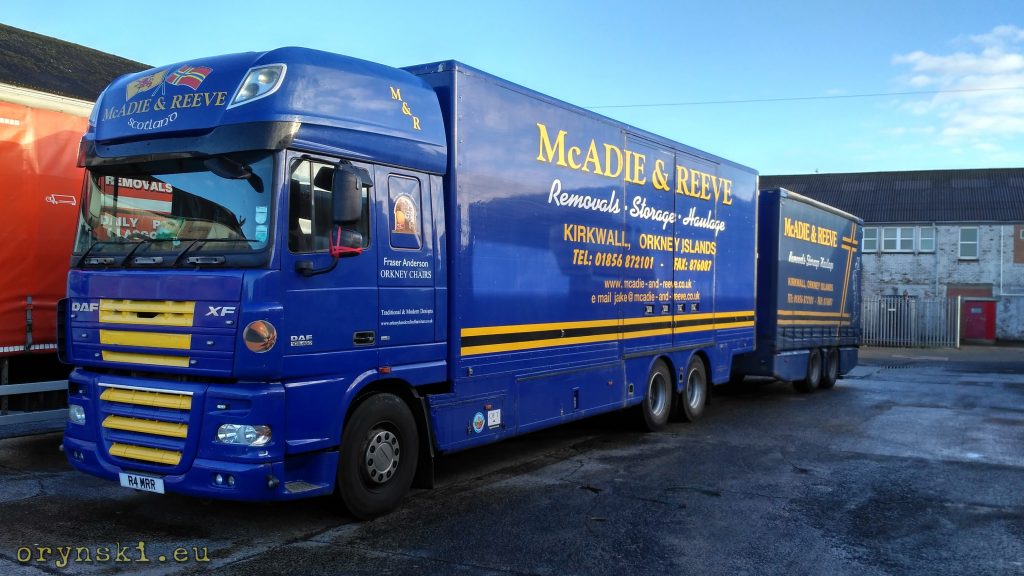
Yet another regular route served by Glasgow depot is firth of Clyde: regular journeys to Isle of Bute and Cowal Penninsula are served, depend of the current demand, by 3.5t Mercedes Sprinter with a luton box body, or 10 metre 18-tonner DAF CF. A bit longer journel via Oban to Campbelltown is served by yet another 12 m long 26 tonner. This one has steering rear axle so it can maneuvre easier in the narrow roads of Kintyre penninsula and unloading cargo in rural area is facilitated by a giant tail lift that serves also as rear doors of the vehicle.
Hebrides Haulage is capable of delivering your cargo to pretty much every Scottish island – either with their own network or dedicated vehicle, or thanks to close cooperation with another companies, of which many also have vehicles made to measure. B. Mundell Ltd, serving islands of Islay and Jura possess an unique double-decker semi-trailer in which the lower deck is occupied by a fuel cistern and upper deck is capable to carry any other cargo. Shetland Transport, Barratlantic and Arran Deliveries both serves relevant areas. Companies that serve smaller islands ofter use very short vehicles based on light Asian trucks such as Isuzu, Mitsubishi or Toyota Dyna. On the other hand our Orkney Specialist, McAdie and Reeve uses rigid DAF XF lorries with bodies similar to those used by removal companies, that thanks to the system of movable floors and side doors allows to carry goods in countless configurations.
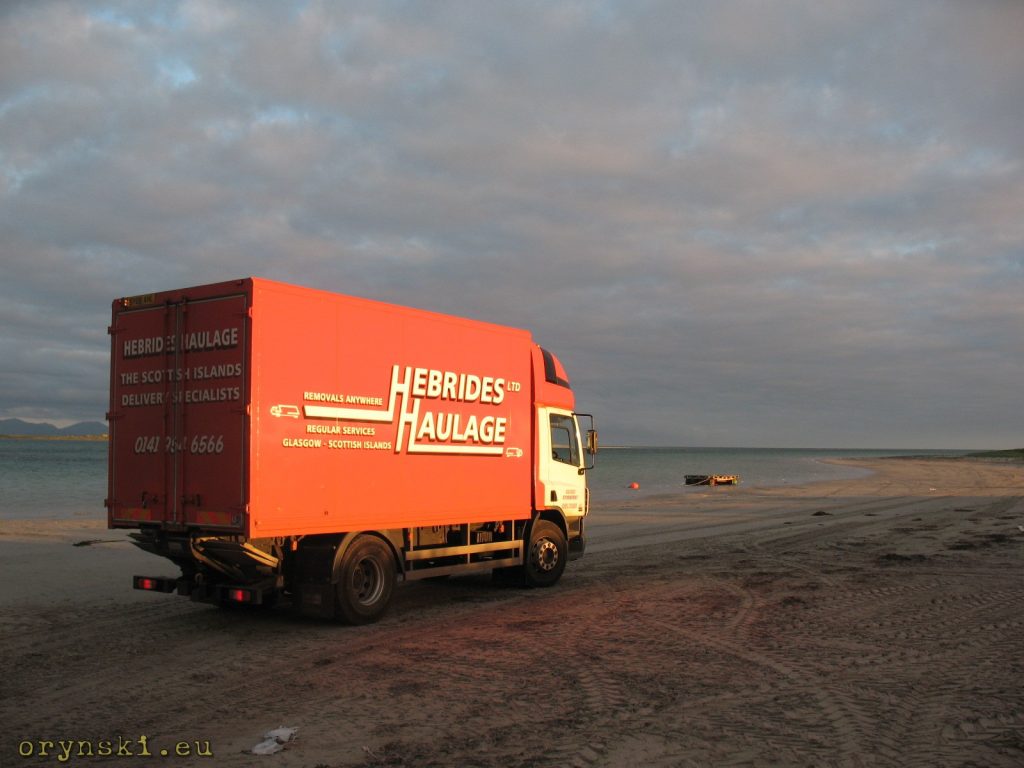
Until recently, also Hebrides Haulage itself was running a very unusual vehicle: unusually short (7.5 m) 18 tonne DAF CF with a sleeper pod on the roof looked almost like a toy. So far there is no talk about purchasing it’s replacement, as it’s duties can be carried by 7.5t and 26t truycks with container bodies that are part of the fleet – the latter often makes very unusual configuration when it pulls an open bed trailer on it’s way to Stornoway.
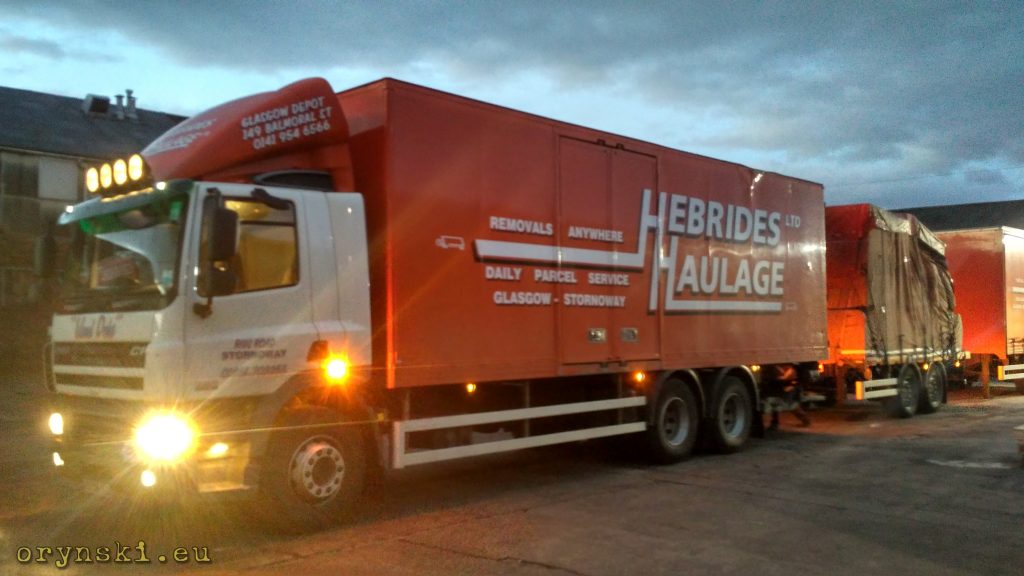
The last of the regular routes served by Glasgow Depot is that to the middle part of the Outer Hebrides Archipelago. 10 metre long 26 tonne DAF CF twice a week leaves for Uists and Benbecula, islands located between biggest Lewis and Harris and most southern Barra. The fleet of Glasgow Depot is topped by a Mercedes Sprinter panel van in rare configuration: short wheel base with high roof.
People
Being a Hebrides Haulage driver is not an easy job. Forget about just driving from A to B, after returning to the yard you will be expected to help load the lorries for the night or the next day. And it might not be the first time where you were required to do some hard graft: loads are often delivered to rural places, where there is no other option as to handball it off. Also reaching those places is not easy – many of those places are really remote, and single tracks of Scotland require much more skill than pure motorway driving. And I mean that: Hebrides Haulage truck on regular basis visit places, that many speditors would consider “unsuitable for HGV’s”:
Those narrow roads often lead through bogs and moors, going off the tarmac by even few inches might result in getting stuck in mud if you are lucky. And this time there is no exaggeration: many times after making just one step off the tarmac one can sink in the mud up to the ankles. Driving in Scottish Highlands is literally living on the edge.
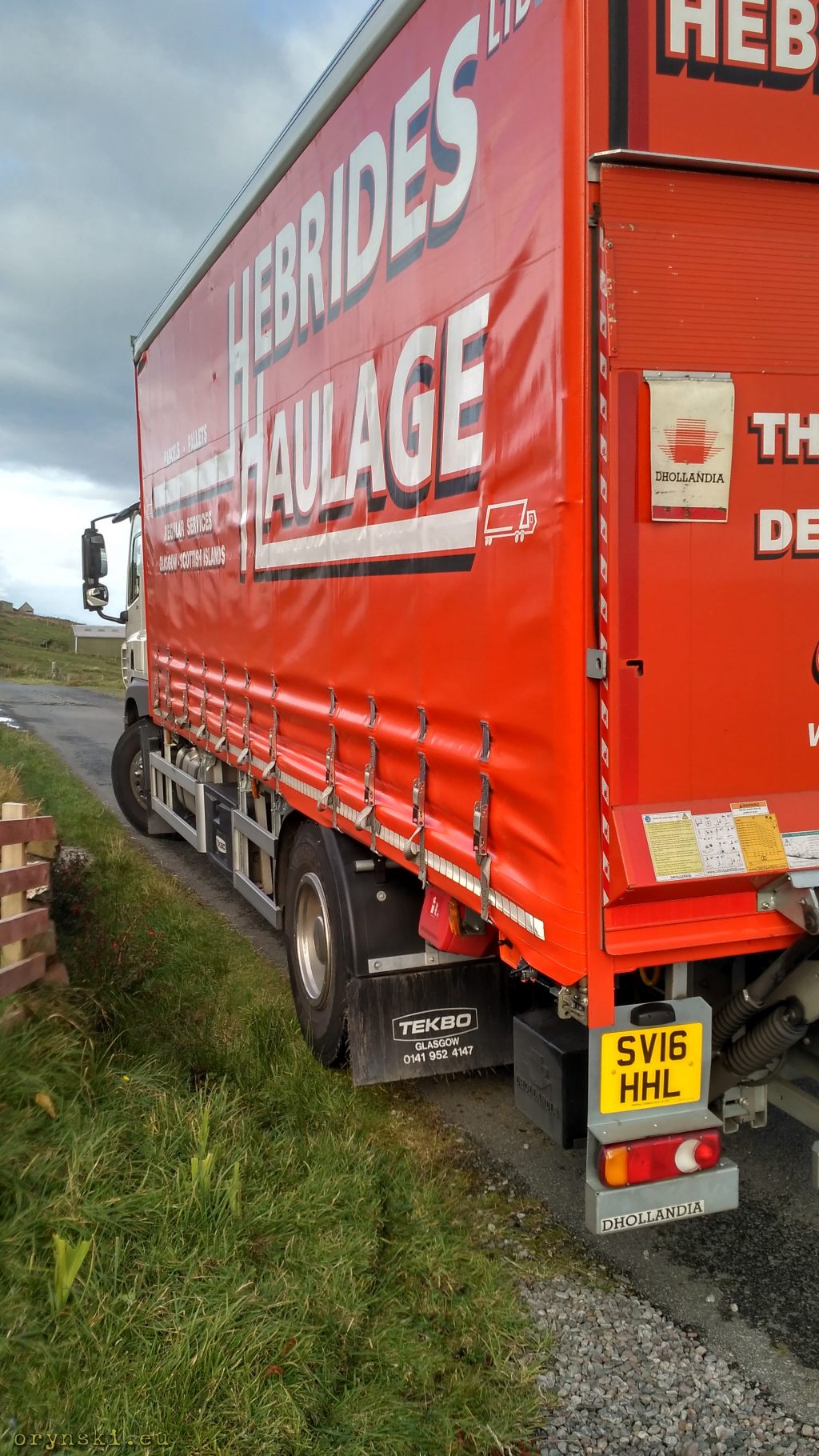
Luckily, drivers are not left to their own. Hebrides Haulage is a family company, run by brothers, who are not afraid of hard work themselves, as they were taking part in the life of the company since their earlies age. They hope for the new generation to follow their steps, hence the cherry of the cake of the company fleet: a child version of the wagon and drag build by the company engineers
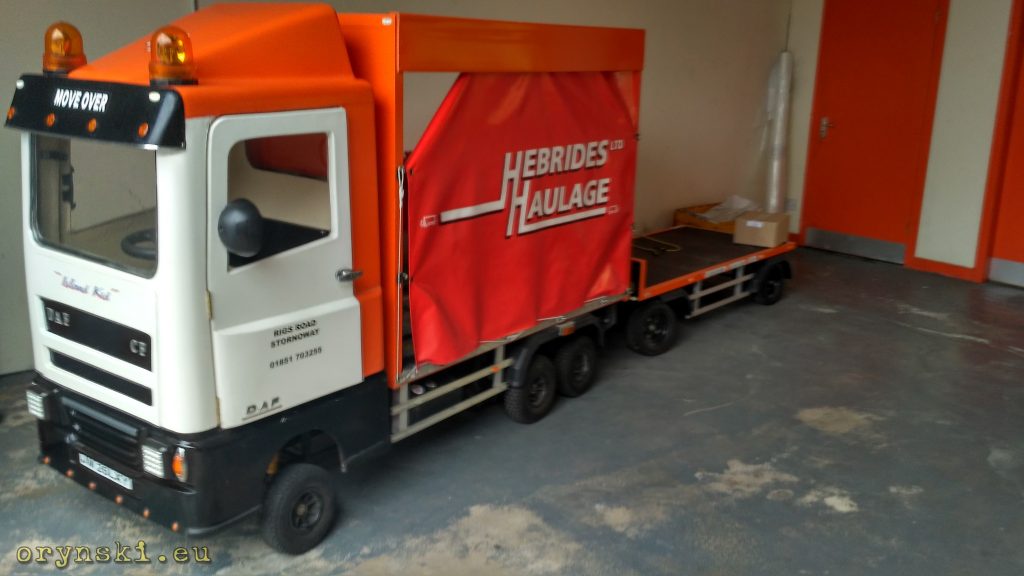
Murdo, who manages Glasgow Depot, is not afraid to jump on the forklift or behind the wheel of the lorry when the need arises. Often he will be the first to meet the driver and help him to unload the cargo. And he is not the only office worker who is qualified to drive HGV, which sadly becomes a rare thing. Also, Hebrides Haulage trucks are not your usual neglected hire vehicles, they are well maintained and they benefit from the boss’s eye. Enough to mention that after bringin the truck from the garage, Murdo himself takes out a torque wrench and check every single wheel nut. This is why the oldest vans in the fleet, while having over 720 000 on the clock, can put many much younger vehicles from other companies to shame. It has to be mentioned as well, that while no driver has his dedicated vehicle, all of them care to keep the cabs clean.
At the same time, if something goes wrong, people of Hebrides are patient. It would not be the first time when something got wrong and they had to wait for their goods for several days – they are used to see ferry cancelation lasting several days in the row. Therefore there is no stress as some delays are not the end of the world.
Me
And what is my role in all of that? Hebrides Haulage was the first company in which I had a proper job after my arrival to Scotland. For two days every week I was driving around Glasgow, then I was leaving for Uists and Benbecula for the remainder of the week. Hungry for the new adventures I moved forward and for nearly 10 years I was doing pretty everything: I was going to London city centre, I saw most of Europe from behind the wheel of a small van, I graduated from Scottish university, helped to run a Polish internet portal, served as interpreter for Strahtclyde Police and tried myself in a role of the corpo-worker in the IT company. This last job convinced me, that I have not been created to spend my life behind the desk, clicking some numbers in Excel, especially that it was draining me with all my time and energy and I had no time for my writing. So when I saw the advert in which Hebrides Haulage was looking for part time driver, it was no brainer. Today I realise myself as a freelance journalist, and from Wednesday to Friday I climb behind the wheel of the orange lorry. Sometimes I am lucky to be sent to some beautiful places – from time to time I even have a chance to cover my old route to Uists and Benbecula. And where I cruise through the spectacular views of Scottish Highlands, passing tourists cars parked in the most attractive photo-spots, I think to myself making a living by going to the places where other people are willing to pay hefty money to reach can be one of the best jobs under the sun. More on that – in the next chapter of this reportage.
CLICK HERE TO READ SECOND PART OF THIS REPORTAGE
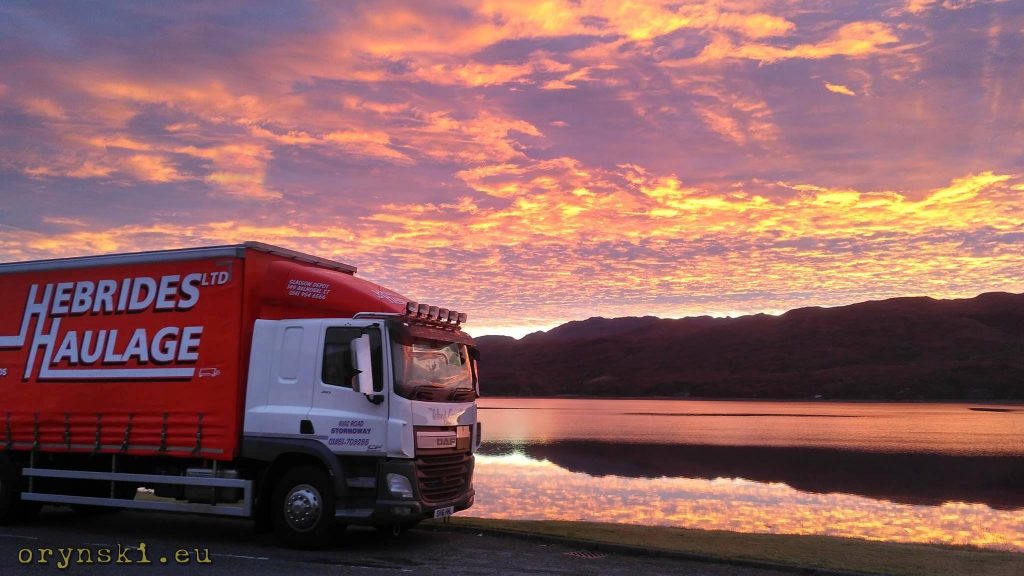
This piece was originally published in Polish at 40ton.net

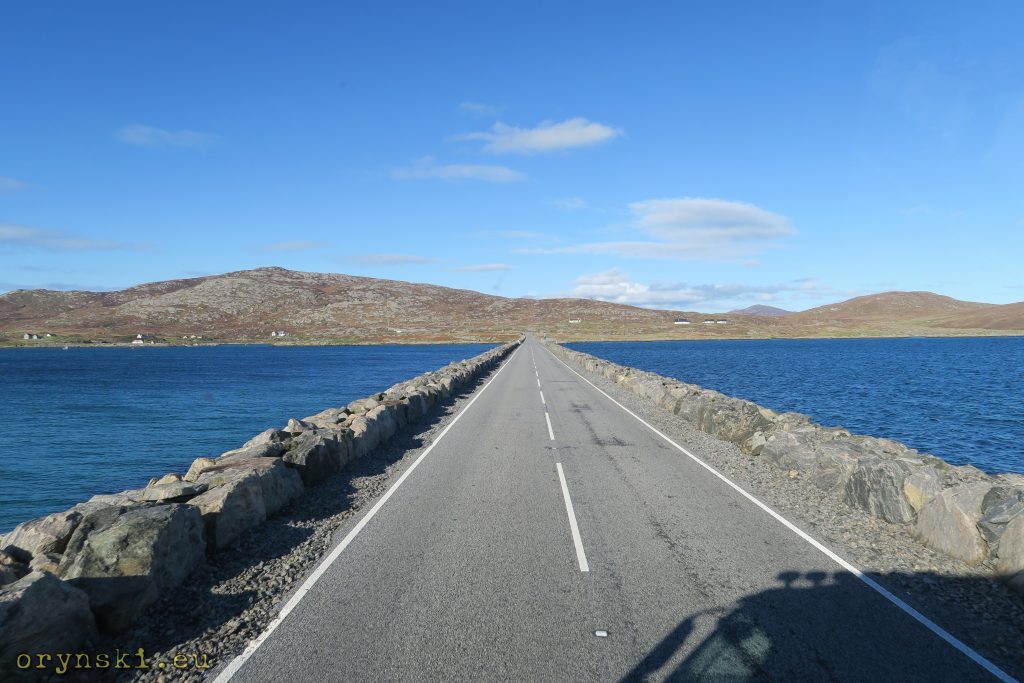
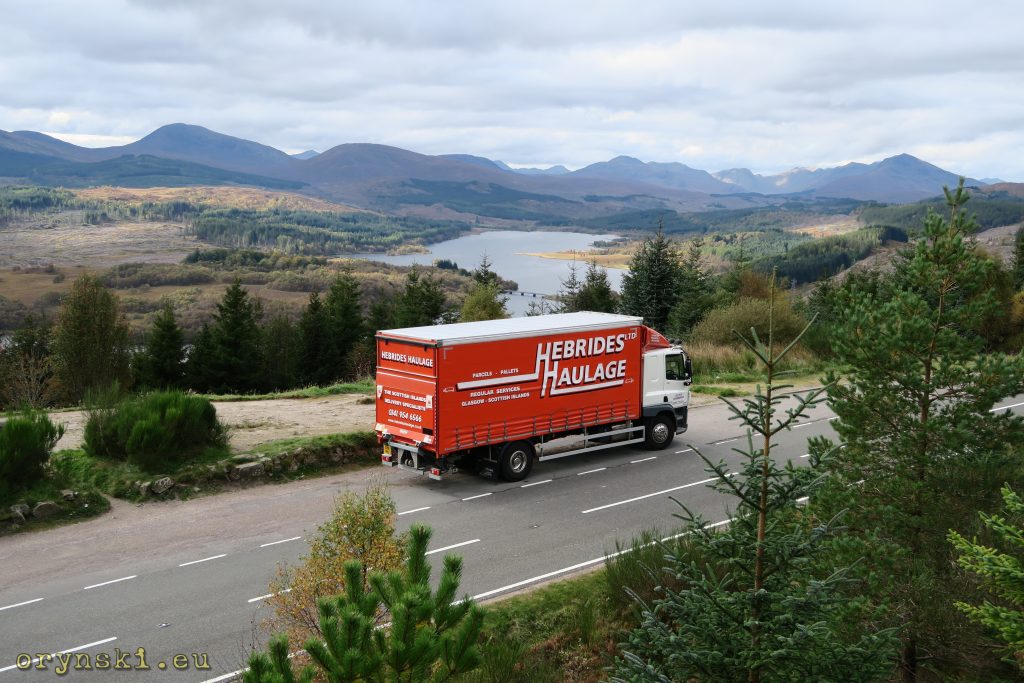


[…] the first part of this reportage we presented you with an overview of the Scottish transport company, Hebrides Haulage. This company […]
[…] previous parts of this feature we have been introduced to the life of a Scottish transport company, providing haulage services to a small community of people living on the Scottish Western Isles. […]